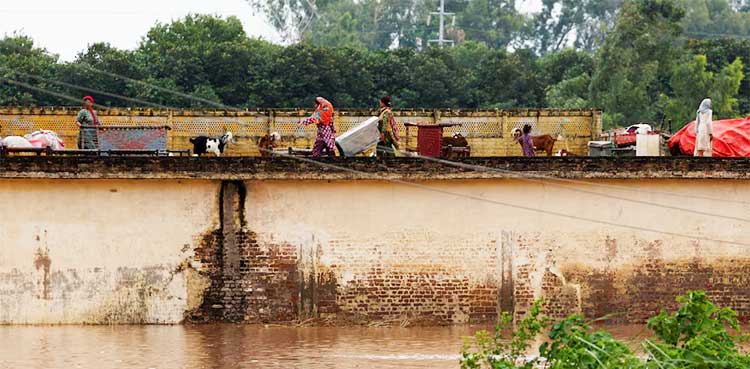August 27, 2025– As Pakistan grapples with yet another season of relentless monsoon rains and recent floods, the nation’s history of catastrophic flooding comes into sharp focus. From the flash floods that ravaged Balochistan in 1998 to the unprecedented deluge of 2022 that submerged a third of the country, and now the ongoing 2025 crisis claiming hundreds of lives, these events underscore the escalating threat of climate-driven disasters.
The situation calls for us to look into a pattern of increasing intensity and widespread damage, with vulnerable communities bearing the brunt. Adding to the complexity, India’s recent release of water from its dams in the Occupied Kashmir, following heavy rains, has heightened flood risks in Pakistan, particularly in Punjab, which faces an “exceptionally high” risk due to cross-border water flows.
The 1998 Floods: A Localized Tragedy
The 1998 floods, though less documented than recent calamities, marked a grim chapter in Pakistan’s disaster timeline. Triggered by intense flash flooding in March, primarily in southwestern regions like Balochistan, the event was characterized by sudden, high-velocity water surges amid poor weather conditions. Over 300 people lost their lives, with an additional 1,500 reported missing, as rescue efforts were severely hampered by damaged infrastructure and inaccessible terrain. Approximately 200,000 individuals were affected overall, with 25,000 left homeless after more than 3,700 homes were destroyed.
While economic losses were not comprehensively quantified at the time, the destruction of homes and roads inflicted lasting setbacks on local economies, particularly in rural areas reliant on agriculture and basic infrastructure.
The 2022 Deluge: A National Catastrophe
Fast-forward to 2022, and the scale of devastation reached apocalyptic levels, often described as Pakistan’s worst flooding in history. Fueled by record-breaking monsoon rains—exacerbated by climate change—the floods inundated one-third of the country from June to September, affecting provinces including Sindh, Balochistan, Punjab, and Khyber Pakhtunkhwa (KP). Intensity was extreme, with rainfall exceeding historical averages by 7-8% in some basins, leading to widespread submergence and flash floods.
The human toll was staggering: around 1,700 deaths, with 33 million people impacted and 8 million displaced. Infrastructure crumbled, with over 1.5 million homes destroyed or damaged, and 4 million hectares of agricultural land—key to crops like cotton and rice—ruined. Economic damages soared to an estimated $30-40 billion, pushing nearly 9 million more into poverty and triggering long-term issues like food insecurity and disease outbreaks. Experts attribute the amplified severity to melting glaciers and erratic weather patterns, turning what was once a seasonal blessing into a national emergency.
The 2025 Crisis: A Haunting Echo
Now, in 2025, Pakistan faces a haunting echo of these past tragedies, with monsoon floods since late June claiming at least 802 lives—half in August alone—many from flash floods, landslides, and glacial lake outburst floods (GLOFs)—as heavy rains batter KP, Punjab, Sindh, Balochistan, and Gilgit-Baltistan. Climate scientists note that global warming has likely intensified the rainfall, exacerbating urban and riverine flooding in exposed areas. As of August 26, provincial breakdowns highlight KP as the hardest hit, with 479 deaths in districts like Buner and Shangla alone, alongside over 4,000 homes damaged and 674 schools affected. Nationally, nearly 1,000 people have been injured, over 4,700 homes destroyed, and thousands displaced, including 24,000 evacuated in Punjab’s floodplains.
The situation has been further complicated by India’s release of approximately 200,000 cusecs of water from major dams in its part of the Kashmir region on August 27, following heavy monsoon rains. This has prompted warnings of potential downstream flooding in Pakistan, particularly in Punjab, the country’s breadbasket, which is home to half of its 240 million people. Pakistan’s disaster management authorities issued alerts for flooding on three rivers flowing from India, with the army deployed to assist in rescue, relief, and evacuation efforts in already inundated areas. The number of displaced people in Punjab alone has now exceeded 167,000, including nearly 40,000 who evacuated voluntarily since August 14. Pakistani officials noted that India had issued two prior flood warnings since Sunday, highlighting the recurring challenge of managing cross-border water flows, a routine practice when Indian dams reach capacity.
Economic losses remain unquantified amid the ongoing crisis, but damage to bridges, water systems, and irrigation channels signals billions in potential recovery costs, with health issues like malaria and skin infections surging. The National Disaster Management Authority (NDMA) warns of continued high flood risks in rivers like the Sutlej and Chenab, with more rain expected until mid-September.
Comparing the three events reveals a troubling escalation. The 1998 floods, while deadly, were more localized with around 300 confirmed deaths and 200,000 affected, reflecting lower population density and less intense global climate influences at the time. By 2022, the crisis ballooned to affect 33 million, with damages amplified by rapid urbanization and deforestation. This year’s floods, though not yet matching 2022’s scope, have already surpassed 1998’s death toll and show signs of similar widespread disruption, driven by increasingly unpredictable monsoons and compounded by cross-border water releases from India. The tense India-Pakistan relations, strained further by a brief conflict in May 2025—the worst in decades—raise concerns that flooding attributed to Indian dam releases could inflame bilateral tensions.
Experts in Pakistan and abroad have urged a shift from reactive relief to proactive adaptation, including better early warning systems and resilient infrastructure. As one survivor in KP told reporters, “We rebuild, but the waters keep coming stronger.” With climate change fueling these patterns, and the added complexity of cross-border water management, Pakistan’s floods are no longer rare anomalies—they’re a new normal demanding urgent global action.

Leave a Reply